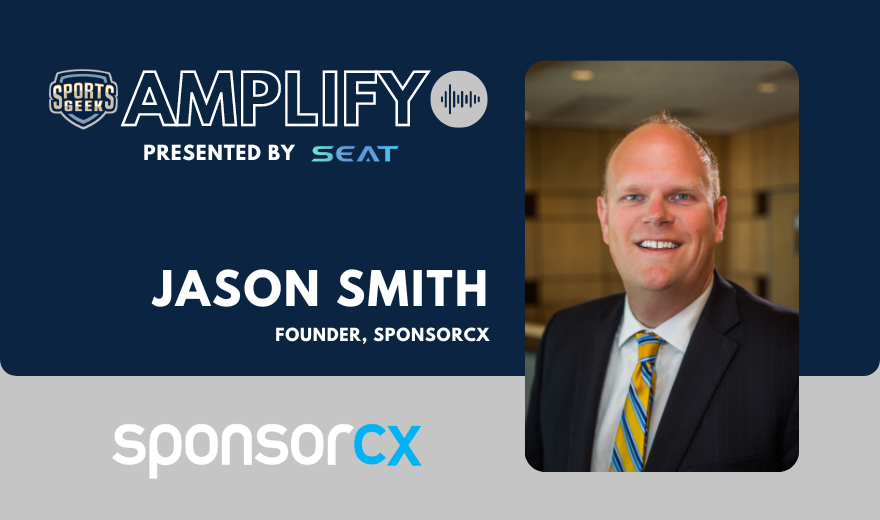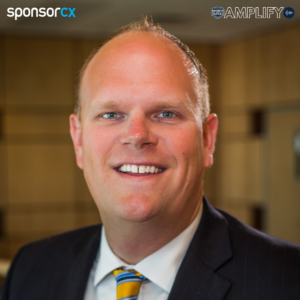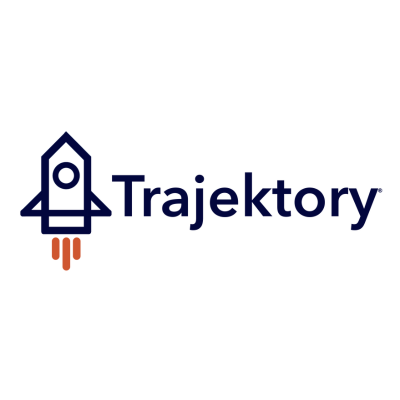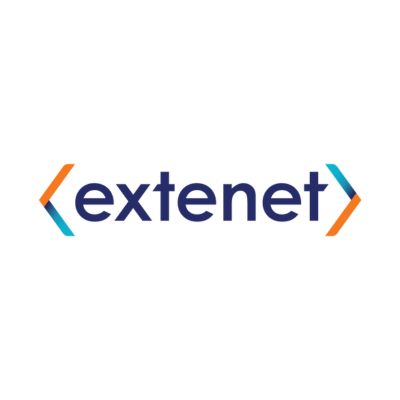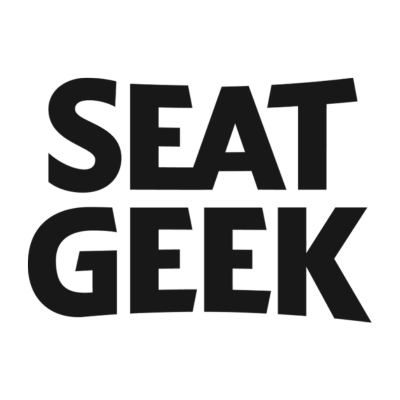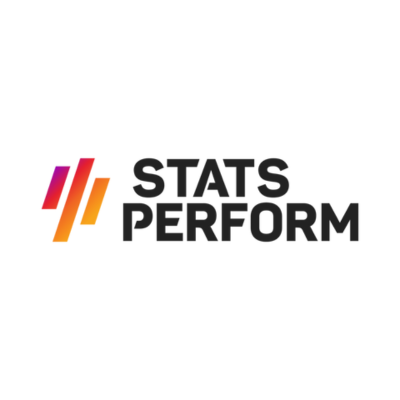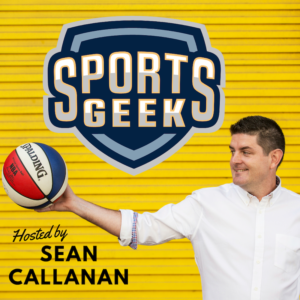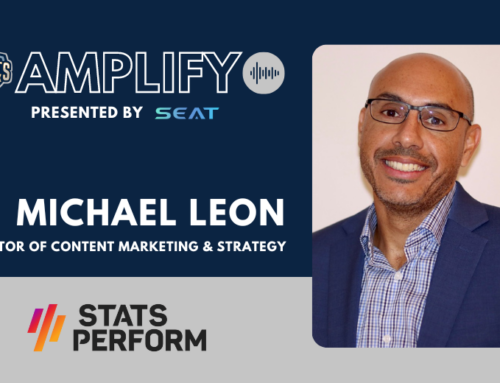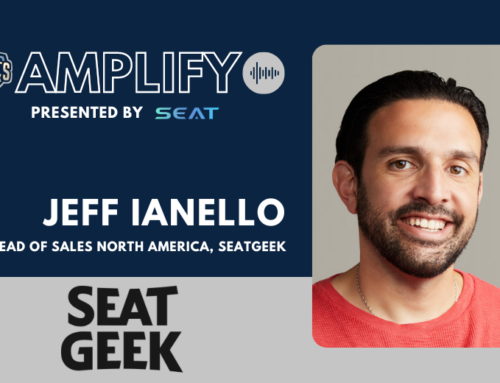SponsorCX provides sponsorship management software that streamlines analytics, reporting, and asset value measurements in an easy-to-use platform.
Learn about SponsorCX from CEO Jason Smith, an experienced sponsorship executive working on both sides of deals.
In this Sports Geek Amplify episode, Jason Smith from SponsorCX shares how his sponsorship experience ensured the sponsor relationship is the focus of SponsorCX.
What you'll learn from Jason Smith
The fact that you're plugging SponsorCX into all of those sources and making it available in the platform right there, that's the beginning of the savings.
Please be kind. Transcribed by bots may contain some errors.
Sean Callanan (00:01.401)
Welcome to Sports Geek Amplify series presented by SEAT. SEAT will be at Salt Lake City in July 14, 15, 2023. Register at SEAT Conference. This episode features SponsorCX. Very happy to welcome Jason Smith. He's the founder of SponsorCX. Jason, first thing I wanted to find out, I'm really interested in founder origin stories and how you came about the idea and how the product like Sponsor CX came about.
You want to give us a little bit of a background of the origin story for SponsorCX?
Jason Smith (00:34.642)
Yeah, I'd love to. No, first of all, thanks for having me on the, on the podcast today. Um, but yeah, I think probably it'll help by sharing a little bit of my story. I, um.
worked for the Utah Jazz for about four or five years and selling sponsorships. Then I went to IMG College, which was ISP and I was part of that merger with IMG. I was at the BYU property and helped grow that property from about $600,000 in revenue to nearly 10 million a year in revenue over a seven-year period.
and they continue to do great there. But yeah, spent over a decade on the sales side of the business and used some pretty antiquated systems, but I didn't really have the idea to sponsor CX at the time. After I left IMG, I went to the brand side of the business and worked with Mountain America Credit Union as their VP of sponsorship for about eight years. And it was there, while I was there working with organizations and sports, arts, events,
entertainment, you name it really. I saw the disconnect on how brands and properties kind of manage sponsorships together. That's where SponsorCX kind of came from as I was working with all these different organizations and I saw how archaic it was. Having used a lot of different platforms on the sales side, I decided to kind of take it in my own hands. I invested $30,000 of my own money and went overseas.
and built our beta version of the platform. This is back in 17, 18. And after I got kind of the first version of it built, I pretty much gave it to five people who I knew, organizations in the industry that I knew to use it and tell them to beat it up and tell me all the good and the bad and the ugly. And they came back and two of them were like, hey, we love this, we'll pay you for it. And three of them were like, hey, Jason, this is great.
man, there's so much other stuff that you have to build out. And so long story short, I connected up with my partner and now CTO, Creed Mangrum, he's an MIT guy. We got connected up and we ended up…
rebuilding it from the beta version. You know, just from the feedback that we got, it just made a little bit more sense to rebuild. And so we spent the next 18 months, you know, doing that. And then we launched it end of 2020, December of 2020, like middle of the, right before the Christmas holiday, we kind of launched it. And, but it was really that time when I was on the brand side working with a lot of different organizations, I just saw how archaic it was. And there wasn't a really good solution.
out there that was simple, easy to use, that helped on that side. So we went to focus on the property side of the business, the sales side of the business first. And yeah, that's kind of where things started for us.
Sean Callanan (03:47.013)
So I think it's really unique. A lot of people start from one side of the problem, but the fact that you'd been on the sales side, been pitching to partners across all the different assets and understanding it from the pressures from a point of view from a, you're the rights holder and you've got all these things to sell, but then also on the other side, when you're at the credit union, when you're managing multiple portfolios and trying to compare them and…
and that you would have been getting multiple different ways of reporting things and keeping you up to date, was that sort of the light bulb moment when you were on the brand side to start seeing how all the different industries, either all in sport or across different industries were solving the same problem differently and it was a bit inconsistent from a brand side.
Jason Smith (04:36.074)
Yeah, I know this is a sports geek podcast, but like sports make up the majority of sponsorships, but it really for me was even more eye opening when I looked at the other areas outside of sports.
as well too. And I wanted to have a, I wanted to create a platform that was powerful enough for the sports organizations out there, but also for the arts and the events and some of these other, you know, smaller, you know, organizations as well that might be doing, you know, a hundred thousand dollars in sponsorships rather than a hundred million, right? And, and, and, you know, I feel like we've created something that's powerful enough to be able to support a hundred million, but also, you know, flexible and easy enough for
an organization that's doing 100,000.
Sean Callanan (05:20.913)
So we've discussed the origin story and the problems surrounding it. And there's probably people nodding and saying, yeah, we've got these problems. So we probably should be telling them what SponsorCX does and what it is overall. So if you've got an elevator pitch for what SponsorCX does and who uses it.
Jason Smith (05:32.086)
Yeah.
Jason Smith (05:39.306)
Yeah, so are we…
We provide what we currently call our property product, which is sold to those organizations selling sponsorships to be able to manage all their accounts contacts, manage the inventory that they have available, sponsorship assets available to sell, being able to put those customized packages for the brands together in a really streamlined and easy to use way, and be able to generate proposals, term sheets,
Jason Smith (06:13.032)
to be able to take to the sponsor and then once it's executed, upload it into the platform and from there you can push it into an activation fulfillment portal where you can do all the task management, the proof of performance, artwork approvals, things of that nature and be able to invite the partner to be able to collaborate with you internally in the platform as well too
Jason Smith (06:42.032)
worked on and what the properties done for the brand. And so that's really, it's kind of end to end sponsorship management. We also have a mobile app that you can, that these properties can use to be on site, to capture video or photo and be able to upload it directly into the platform to that asset that they're taking a photo or a video of and then be able to generate a post season recap, right? Of all those things that you've done.
and for the sponsor as well.
Sean Callanan (07:16.089)
And so from you talked about having a couple of founding clients that were good enough to be testing the beta, who are some of the clients now that are using it as a platform? Both from that sales piece and then that real important piece, because there's normally that disconnect and that activation piece, because you can have the best sales people in the world and they build that relationship and they get that sale and then it doesn't quite get the…
hand it over to all the different departments that have to execute it, whether it be, in stadium and the signage or an event activation or the world that I play in, in the digital space, trying to get that communicated can sometimes be difficult. Is that the space that Sponsor CX sort of leads the way in helping that communication and that cohesiveness across the organization?
Jason Smith (08:08.982)
Yeah, it helps streamline it across the board from sales to activation and both of those teams together, being able to kind of work in sync, you know, and lock and step that way. And I mean, we have organizations from, you know, zoos and aquariums like the Living Planet Aquarium that's based here in Utah, where we're based, you know, here all the way to the New York Red Bulls. Right. And so we have power, you know, big five sport teams and everything, you know, and everything in between.
right? And so that's the fun part about this is we also have, you know, nonprofit organizations like the International Association of the Study of Lung Cancer, right? You know, that use it to manage their sponsorships for their conferences and things like that, but it's also fun to see it used in the sports world as well too. So yeah, it's fun to just see the multiple uses of
the platform. It just makes it really really easy to use and customizable to any to any area can be used.
Sean Callanan (09:13.478)
Have you seen?
Have you seen any pushback or feedback in that part of bringing in the brand? Because sometimes there is that concern, you go and sell it and then you're, what happens normally is you're getting to that reporting phase and there's that, oh crap moment of we didn't deliver that or we didn't deliver this or we need to do a make good and.
Jason Smith (09:38.379)
Yeah.
Sean Callanan (09:42.381)
I guess bringing the brand into the full lifecycle of the sponsorship sort of opens that up. Is there some fear there for some organisations to say, well, we don't really want to bring them in or is it the reverse in that the transparency starts helping and makes the sponsor a bit more flexible and you're seeing better opportunities.
Jason Smith (10:04.894)
I mean, I'll answer in two ways. Sitting on the brand side of the business, I love the transparency, because then it's a collaboration, working together to get something done, rather than someone just, you know, just the property's operating, and then just showing up after a year and saying, oh, this is what we did. We actually, because even if there is a mess up, like you can quickly, you know, capitalize on it. There was multiple times when I sat on the brand side of the business and I would go to a game and sit there and see an added value.
piece, like a bonus piece that they would do, but they did the wrong logo. Like it was a logo from like 10 years ago. And, and as much as I, I really appreciated it and I truly did, like I appreciated the bonus assets, but I know that if my CEO is sitting there and saw it or my CMO, it would be like, well, why does it look like that? So there's the conversation of like, Hey, I love this. This is so awesome. Thank you. But if you could have just shown that to me real quick before it went up, then
of like, you know, fix that piece. And so there's that balance of like showing appreciation, but yet at the same time, like, oh, that was the wrong logo. I'm a big fan of transparency with that. Now with our customers that use the platform, some of them use that feature and some of them don't. And you can, I mean, it just depends on their processes and what they feel is appropriate for them. But it's there available to them.
them to be able to use to be able to invite the sponsor to collaborate. But in a worst case scenario, we do have the ability to export it and do a spreadsheet and send it to the partner. So there's two ways to do it. You can either export it, send it to them and be like, here's the activation guide that you can send them or you can invite them in so you're looking at the same stuff. So there's flexibility in the platform, but those are my thoughts on that. Yeah.
Sean Callanan (11:45.383)
Yep.
Sean Callanan (11:59.237)
Yeah, but also the fact that you've now got an internal process to add those extra, but if you do those added values again, sometimes it happens in social where you take a great photo and the signage behind happens to be the sign. So it's not even something you do consciously, but the fact that now you can log it and put it in the system so it can go back to the partner to say, hey, we did this, it wasn't something we did intentionally, but that celebration pic had your sponsor in the background.
Jason Smith (12:25.75)
Yeah.
Sean Callanan (12:28.761)
it becomes one of those key stories. So it starts building that trust and building, like you said, the transparency. So you're building on that relationship throughout the year and you're not just in that heavy sales phase and we've got to close them. You're in closed mode and you've got to close the sponsorship but you're actually building towards that next partnership all the way through the year. And I guess that's where it's a key tool for your sponsorship exit.
your coordinators and your sales staff to maintain that relationship throughout the year.
Jason Smith (13:03.358)
Yeah, and I think the key is I love the consistency too, like throughout the year of touch points rather than.
then because it's really easy to your point in the sales process it's really easy to just kind of like hunker down and just focus on sales and then all of a sudden the end of the year comes and you're like oh man I got to do a recap for them and you haven't talked to them in eight or nine months or however long it is right and you're like oh I need more money for next year that's a that's a different conversation rather than if you're like a true partnership where you're kind of working through it throughout the year.
Sean Callanan (13:35.421)
So from a customer point of view, you know, where you'll be meeting, you know, people who are working on the team side at C2 or working in venues that are selling inventory and those kinds of things. Is there a particular role or a person internally that comes to you and says, we, you know, we need sponsor CX. This is the issue. We want to have a better management with our partners and keep them more informed and be able to understand what they want, but also continually.
having that conversation, does that normally come from the sales side or is there other parts of the organization that sort of raise their hand and say we need assistance in the space?
Jason Smith (14:17.93)
we replace spreadsheets all the time, right? And so it's like, you've got anyone who's kind of managing spreadsheets and just sick of it, and they're in the sponsorship space, they're the ones who really gravitate to our product. But to answer your question, you know…
Obviously, sponsorship sales is a great place to be, whether it's the chief revenue officer, the VPS sponsorship managers, whoever it is there, activation teams as well. We'd like to make sure they're taking a look at the product too. Then we'd like the BI business intelligent teams to get involved as well too. Sometimes accounting will get involved when you start, when you're generating invoice schedules and things like that.
Jason Smith (15:09.592)
I always like to say we're powerful enough to stand alone as a software, but we're also flexible enough to integrate with other platforms. So like we have Salesforce and Dynamics integrations. We have other accounting platform integrations. So when they generate invoice schedules on our platform, it actually generates them in their accounting platforms as well too. So we try and make it as streamlined and as easy as possible for people and just evaluate their processes.
get involved. But there usually has to be some sort of a driver, someone who feels the pain, which is usually sponsorship activation. You know, so the sales team or the activation team usually will drive from.
Sean Callanan (15:52.273)
So with most SaaS products, it's set up a login and start doing setup. What does the onboarding and the setup process look like for SponsorCX? Is it a process of sitting down with the Sponsor folk? Is it an audit of what you've got from an inventory point of view? What's normally the starting point that you and the team work with? Or is it literally someone turns it on and they just start using the system?
Jason Smith (16:19.993)
Yeah, so we have a great customer success team.
And once we've kind of executed an agreement with someone, we have a kickoff call with our CS team. And there's usually an assigned CS manager to that account. And they will work through that whole process with them, whether it's taking Excel spreadsheets and dragging and dropping them into the platform. And within like seconds, they're uploaded, they'll CSV uploads, whether it's inventory, accounts, contacts, that way.
or if we need to do some sort of integration and pull, you know, accounts, contacts and those types of data points from like Salesforce. Just depends on, you know, the size of the organization and what they need. Can take a little bit longer than others, but it's usually a fairly quick process. It's a matter of getting the information from these organizations. Sometimes it's a nice time to do an audit on all of your data and info, and so sometimes, you know, that can take a little bit of time if they're
wanting to redo their inventory right before they get it into the platform and things, which we encourage them to do. It's always kind of a nice time to just do an assessment of your inventory and do it that way.
Sean Callanan (17:38.309)
And then from a customer point of view, if you're on the brand side and you're starting using SponsorCX and it makes it easier to effectively have that plug and play nature of this, this partner's agreed to this, this and this and your ticking boxes and hitting buttons and the proposals are going out and terms are going out. What's the experience like on the brand side? Like you sort of said, you've got the ability to have them fully integrated and be part of, have access to what they're doing or you could have that separation and…
they don't really know that using sponsor CX. Is there much on the brand side when you start saying, oh, click on this link and they jump into a system and start seeing what's happening from inside their own deal?
Jason Smith (18:20.798)
Yeah, they jump into the account. So like when they're invited by the organization to collaborate, they do get an email saying, hey, sign up here. So they're getting it from their contact. You know, they're saying, hey, I'm inviting you to collaborate. And usually a discussion's been had before, you know, that's coming. And then when they come in, there is some limitations that they have to be able to like change anything in there. But they don't see anything other
Sean Callanan (18:33.927)
Yeah.
Jason Smith (18:50.832)
fulfillment tasks that need to be done and some of those can be hidden and all of that I won't get into the nitty-gritty details of it but they're able to see you know the proof of performance and like what has been fulfilled like once been completed and the nice thing is is that you can the properties can actually assign tasks to the sponsor to do too like if they need to send something along you know to them then they can create that task and have
Jason Smith (19:20.592)
that they know when it needs to be done and the system will actually remind them like, hey, by the way, XYZ sponsor, you need to send over this LED artwork, right? Or whatever it may be, right? And upload it. And so it just holds everybody accountable on those things in the system. You know, sponsor CX allows…
basically helps them stay on task with those notifications and like, hey, this needs to be done and just allows for just that seamless communication.
Sean Callanan (19:53.701)
Yep. And if you found when you've been going through that on-boarding phase, you know, it is a national time to do a bit of a refresh and a bit of an audit. One, have you found partners, you know, find some revenue, find some things that they have been delivering, that they haven't been charging for, you know, the added values that are getting added very often, but not really being recorded and seeing some potential revenue uplift there because they've got that focus of
Jason Smith (20:02.871)
Yep.
Sean Callanan (20:23.633)
you know, reviewing their inventory.
Jason Smith (20:26.846)
Yeah, and we also, I'll kind of note too, like we'll…
We'll even provide some evaluation services too, like if we need to. Like if there's someone who wants to have a greater understanding of like what they should be charging for certain pieces of inventory and all of that, we have a team here too that does consulting work as well too. So I mean, we can help on that side of it too as we're onboarding as well too. So there's a lot of different ways that we can help them.
Sean Callanan (20:58.017)
And then on the brand side, you've sort of spoken about being on the right side, but then on the brand that's coming in, is there, I mean, they're getting the invited, making up words now, the invited view, right, that's coming through, is there still, is there plans for like, again, if you're at the credit union, you're managing multiple properties to be able to have, I guess,
Jason Smith (21:12.135)
Yeah.
Jason Smith (21:19.85)
Yeah, yep.
Sean Callanan (21:25.113)
Yeah, a sponsor side for sponsor CX to sort of how they can manage multiple properties if you're in a spot that you were with like the credit union.
Jason Smith (21:34.474)
Yeah, we have a brand product that's fairly basic today that organizations like brands can use to manage their sponsorships. But first part of 2024, we're hopeful that we can have our full-fledged brand product released then. So we are in the process of building a really robust
Jason Smith (22:04.368)
multiple properties that they're sponsoring. And yeah, there's just a lot of, there's gonna be a lot of aspects to that product as well too.
Sean Callanan (22:12.505)
Yeah, definitely. I mean, it comes with the whole I mean, it's effectively it's a completely different product. But again, looking at the same data in a different way. And, and I think the piece that will be really interesting is that, you know, as you probably end up with more brands going, Hey, hey, Jason, we're really loving the way this part of just being managed. We want this, this and this. And you'll start seeing the benefits of both, you know, whether it's the brand saying, we want this thing tracked or
Jason Smith (22:19.15)
Totally.
Jason Smith (22:28.147)
Exactly.
Sean Callanan (22:37.857)
and or realizing the extra value and those kind of pieces. So I think that's a really exciting part of the roadmap, especially when you've got partners that have, like I said, multiple properties across multiple sports, and hopefully across multiple sponsor CX clients that start saying they wanna make that connection.
Jason Smith (22:57.502)
Yeah, exactly. You've got it spot on. That's the whole reason we will be releasing that robust brand product here in the next nine months or so.
Sean Callanan (23:08.325)
Terrific, terrific. One last thing, because I'm a sports geek, I'm a former geek. Hal, you mentioned connecting with your CTO. How much have you learned in defining requirements, talking to geeks, understanding what you need to ask you to get development done, because you're the brain's…
from a point of view of the customer point of view. You know what the customer wants. You know their pain points. You know, you were the person, you know, up to your eyeballs in spreadsheets and you know the pieces that need to be fixed, but sometimes converting those into the ones and zeros that the geeks understand and understanding how the developers want them. How have you found that process of both communicating with your CTO and also your development team to get the product developed and…
constantly iterate on it.
Jason Smith (24:06.002)
Yeah, Creed, my CTO, he's awesome. He's actually really easy to communicate with. And…
He's a four-year starter on the MIT baseball team. So he's got kind of the sports. He's your sports geek, essentially, right? You know, like he is. He knows all the technical side of things, but he is big into sports, big Red Sox fan. So he's been great to work with, and I couldn't think of a better partner to have on the tech side there and become a very good and close friend.
Sean Callanan (24:20.669)
Yeah.
Jason Smith (24:42.912)
pretty much family to me. And we have about 10 engineers that are on our team here. And it's fun. It's fun to be able to be on our dev. We have daily stand-ups with the dev team and hearing them talk through everything that they're working on. And for me, it's about talking about the vision of it. And then from there, our VP of Ops and our Director of Customer Success and the engineering team, you know, they all get on.
to get together and take the vision of it and turn it into code to do it. But I think the most important thing is that that's how it started was just from my brain, my brain child, but now I use the term customer feedback as doctrine. So now I'm just learning from all of our partners and they'll bring up things and you're like, wow, that's actually a really good idea.
and we should iterate with that. And so that's where it's fun now. We're working on our own ideas, but the customers also help build the platform too as they get in there and start using it, and they come up with these really brilliant ideas.
Sean Callanan (25:58.497)
And now you have a really good feel for, you know, someone asked for, you know, a crazy idea, good idea, bad idea, doesn't matter, but you know, what they're asking for. And you can do a little bit of that analyst interpretation to go, Oh, yeah, I know my tech team can do that. Or I will throw that to my tech team and they'll come back with a solution that fits that, that piece. So you get, you feel like you're getting better. The more you're talking to customers to that go, you know, to have a good feel for, you know, how you guys can achieve it, what the
Jason Smith (26:11.127)
Yeah.
Sean Callanan (26:27.517)
what the runway you'll need to implement those kinds of plans backwards and forwards. And like I said, pretty much take customer feedback and then go, oh, look guys, in six weeks, you'll start seeing that change roll out.
Jason Smith (26:38.878)
Yeah, yeah, runways are tough just because you got so much going on. You get into it, you never know how long it's gonna take. But.
Yeah, one thing I wanted to make sure is with, you know, whether it's sales, CS, and engineering, is that everyone is on the same work. We preach, we're on the same team, right? And so sometimes we might be approaching a problem a different way, but how do we, we're all achieving the same goal, right? And so if we can just speak each other's language just a little bit, or maybe take a little bit of a step back and ask some additional questions, you can be really productive,
the most important things is taking that approach, you can get things done a lot faster by asking some additional questions. Instead of just letting, just explaining it and letting someone go build it and then they come back and it's like, that's not exactly where it was. It's kind of like every step of the way, making sure that there's questions being asked to make sure that we don't have to go back and rebuild things and keep having to go back and rebuild. And so that's the key,
slowing down with engineering actually speeds you up, which is crazy and mind blowing for most people to even think about, but it's so true. I've learned that through these last four or five years.
Sean Callanan (27:53.426)
Definitely.
Sean Callanan (28:03.082)
As someone that used to run development teams in my former life as a geek, yeah, that's paramount. Like, you know, sometimes I wanna run really quickly, but it's like, you've gotta have those checks and balances. And then I think the other piece is, sometimes geeks can be doing a lot of things because the geeks want to do them.
And sometimes you need to say, hey, a customer is, you know, does the customer need this change? Does the customer needs this add-on, this module? You know, what benefit does the customer, when you challenge your developers to say, you know, why will the customer want this?
Jason Smith (28:22.21)
Yeah.
Yeah, yeah.
Sean Callanan (28:37.485)
And then they start thinking like the customer, and they start producing things like, well, if we do this module, everything will be quicker and this will be the benefit. It's like, oh, cool, now you're selling me back to the customer. And so it's a really good exercise. But yeah, that's agile development. And that was the exciting part of when I was part of it. And it's definitely exciting when you've got a product and you can say, oh, yes, you want that change to the customer.
Jason Smith (28:45.459)
Yeah, yeah.
Sean Callanan (29:04.301)
and have that confidence that in four to six weeks or whatever your cycle is, that they start seeing it. And that must be so satisfying for you to see a customer ask for something and get it in a relatively short time period. When you look back at your previous career, when you were on the right side and knowing how long and how slow things might have been from a change point of view.
Jason Smith (29:25.342)
Yeah. And my team's listening to this now going, you gotta slow down to speed up. Cause all they hear from me is like, speed up, let's go. We gotta, so now they're laughing going, see, we have it documented now.
Sean Callanan (29:39.642)
Yeah. Yeah. Terrific. Well, there is evidence. Well, one of the things that, you know, when I'm looking at tech solutions and I have clients say, hey, Sean, can you go and look at this? This solution? One of the things I applied it is the is the triple threat. So I want to tackle these with you. The first one is time.
We all know that the world of sport and sports and entertainment and also that wider space that all do sponsorship Whether they be in the arts or event space there They are stretch for time So I always ask people, you know, does your product is your product a time saver in what way so sponsor CX? Does it help your customers save time?
Jason Smith (30:22.083)
yet does uh… i mean
the more efficient that you can be, the better, especially when you have a system that's reminding you of the things that you need to do rather than like having to remember to open up your spreadsheets and click on which tab and all of that. It's a huge time saver. And yeah, if it's requiring more time, then we need to, you know, for people then there just needs to be, whether it's additional training or we need to look at, you know, functionality of
Jason Smith (30:53.904)
a software you've got to learn it. We pride ourselves on being simple and easy to use, but even simple and easy to use you've got to dedicate the time to learn and just make sure that it's, you know, this is how I use the platform and the faster that you can kind of work through it, you know, the better.
Sean Callanan (31:12.813)
And sometimes it is rewiring how you do things, because you're right, previously you might have been exporting spreadsheets from multiple places and you might be a wizard in Excel and I'm sure a lot of sponsorship folk are because you have to be to look for your own efficiencies, but the fact that you're plugging SponsorCX into all of those sources and making it available in the platform right there, that's the saving to the beginning, even if you did the…
Jason Smith (31:16.93)
Totally. Yeah.
Jason Smith (31:28.589)
Yeah.
Sean Callanan (31:39.453)
the napkin math of, oh, I have to export these three things for each client, I've got 15 of those clients, like it adds up over time. So it's definitely, you know, anytime you can give people time back is valuable.
Jason Smith (31:48.938)
Yeah, we build.
Jason Smith (31:53.162)
And we build on simplicity and easy to use. So if it's not.
If we build something and it's not that, then we won't do it. Like we have, we have some that'll try and turn us into Salesforce, right? And we're not trying to be turning. We're not trying to be Salesforce. We're trying to be sponsor CX, right? Cause Salesforce is kind of this huge robust system. That's everything for everybody. And we, which is great. It's awesome. There's a need for Salesforce out there with, with all the things and tools that they do, but we're sponsorship management. And so, um, we will, we will continue to iterate.
and continue to add features and continue to get better and better and better and better. But the principle will be based on simplicity and ease of use.
Sean Callanan (32:37.485)
Yep. So the second part of Triple H is money. And that's pretty much looking at how do you either save money or help make money. Some tools, you know, focus on revenue and others are looking at cost efficiencies or even a cheaper option. Where does SponsorCX sit on the money side? Can you, we've already talked about saving money effectively from an efficiency point of view, but where does it sit on the money side in either helping save money or make money?
Jason Smith (33:03.094)
Yeah, efficiencies and then also the reporting around the value of the assets that you're selling to, right? Of understanding where are we underselling and where are we, where are some gaps that we have in order to sell certain assets as well too? And you know, where have we been discounting a little bit too much or where maybe are we selling out way too fast and we're undervaluing it and maybe for the future we need to be selling, we need to be, you know, charging more money, you know, for.
And our platform really streamlines that and helps people understand from an analytics standpoint how they're doing with that.
Sean Callanan (33:41.349)
Yeah, so that then provides year on year that revenue growth to be able to say, Hey, we've been delivering this added value next year. It should be embedded into the program or into the deal. So it does provide you those options. Then you did sort of touch on that a little bit on the time and using the tool. What are the resources that are required, I guess, to use the tool? Or who are the people that do use the tool and, you know, who are using it on a regular basis?
Jason Smith (33:52.02)
Exactly.
Jason Smith (34:10.35)
your sales team and fulfillment activation. Those are the teams that are in there the most. I mean, sometimes you'll get some accounting team members that come in that wanna look at, you know, invoicing and things like that. But I would say kind of your day-to-day, people that are in there is your sales and activation teams. And it's just kind of their, they log in every day, you know, as their place to be able to manage everything they need to.
Sean Callanan (34:38.317)
And so it is that, you know, it is their platform of choice. It's sort of taking them out of spreadsheets and, and just, you know, managing everything in inboxes and folders and stuff like that. But you talked about the, I guess, the training piece, how, you know, you like to pride yourself on the easy to use, but.
Like what kind of, you know, if someone says, I'm not quite sure, or how do I use it, or am I using this efficiently? What does your customer success team do to make sure that they are, you know, it's nothing like driving around a Ferrari with a handbrake on. How do you make sure the handbrake's off and people are using the product the way you intend it?
Jason Smith (34:55.309)
Yeah.
Jason Smith (35:08.248)
Yeah.
Jason Smith (35:13.066)
Yeah, it's evaluating. We have some internal tools to just see how people are using the platform so that we can make sure that we're training on the right things with certain organizations. And then just consistent checks with the teams, right? Of like just doing a check-in with them to just see how they're doing, where are there any challenges? Have any of the team members brought this or that up? And then if there is a new team member that
Sean Callanan (35:21.959)
Yep.
Jason Smith (35:43.06)
on board or things like that. Or if somebody just needs like a certain training on how to create an agreement or whatever it is, like we can take the time that we need with them. I mean we have other like videos and tools and things that we can do to provide you know people to be able to do it. But you know if people do want those like one on one touch points, we're always willing to hop on and give those to them as well. We want to make sure they're having the best experience of the software.
Sean Callanan (36:12.313)
Terrific, terrific. Well, we will see you at seat. So if you want to have a chat with Jason and the SponsorCX team, I expect the data analytics folk and some of the digital folk to want to chat to you because they have that.
Jason Smith (36:18.507)
Yeah, I'll be there.
Sean Callanan (36:28.381)
that paid point of occasionally getting sent something and hey, we need this poster for this partner. And it's like, well, we don't want it to be a surprise. We want it to be something we know is coming up. So please check out SeatConference.com, get your tickets. Just give us a bit of feedback what people will expect coming to Utah and why Salt Lake City is going to be a great destination for seat.
Jason Smith (36:39.702)
Yeah.
Jason Smith (36:52.698)
Utah is beautiful. I mean, come and stay through the weekend, head up to Park City if you'd like and spend a little bit of time there. It's always an iconic city to visit. And, but yeah, it's a beautiful time of year. It's gonna be hot. This is the hot season. We just had record snow. So hopefully the runoff will be done by then and the rivers will be nice and beautiful. I'm a fly fisherman. So I will probably be doing some fly fishing. And if there's anyone interested that would like to head out.
Sean Callanan (37:15.527)
Okay.
Jason Smith (37:22.512)
but I'm happy to take them out. I think Josh Barney and I, I think we're looking at potentially taking a group out at some point as well too. But yeah, it's beautiful. If you want to get into the mountains, hiking, fishing, boating, lots of reservoirs, but Park City is always a great place to go. But Salt Lake City is right along the Wasatch Mountains there as you fly in, it's breathtaking. Just look out the window, it's amazing.
Sean Callanan (37:51.593)
It's terrific. I've never been to Utah myself, so I'm looking forward to it. Don't forget, mention the list of the podcast. If you want to catch up with Jason, maybe do a spot of fly fishing, but more so talk about Sponsor CX and how it can help your sponsorship team. Please reach out to him. If you can't find him, come and find me. I'll point him out and we'll find the Sponsor CX team. Tell him that you listen to the podcast. I really want to…
appreciate everyone who has listened, appreciate the time you've taken. Jason, this is the time where I do the Sportsgeek pitch and I take what we've said and I come back to you with what I think the pitch is. Um, and, uh, I'll give it a go and you can, you can assess me and then you can, we can have, we can have a disc, we can have a discussion on how improving it, um, at, at Salt Lake City. Uh, so you know how sponsorships are all about relationships. What sponsors, uh, CX do is help you manage those sponsorship deliverables.
Jason Smith (38:33.087)
Love it. I'm excited to hear it.
Sean Callanan (38:47.453)
keeping your sponsors informed throughout the year. In fact, SponsorCX is helping partners across multiple verticals, not just sports, manage their sponsorship deliverables for better outcomes. That's the SponsorCGig pitch, I should say. So don't forget, if you are interested in SponsorCX, you can go to SportsGeekAmplify.com/SponsorCX. You can check out SponsorCX.com, or all episodes are at SportsGeekAmplify.com
And don't forget to go to SeatConference.com to register. We'll see you in Salt Lake in July. Jason, thank you very much for coming to the podcast. Look forward to catching up in Salt Lake City.
Jason Smith (39:27.655)
Awesome. Thank you. Appreciate you all.
Listen to Sports Geek Amplify – SponsorCX episode now
See you at SEAT in Las Vegas
Join Sean at SEAT Las Vegas in June. All attendees will have the option to claim a discounted Pick My Brain session.


